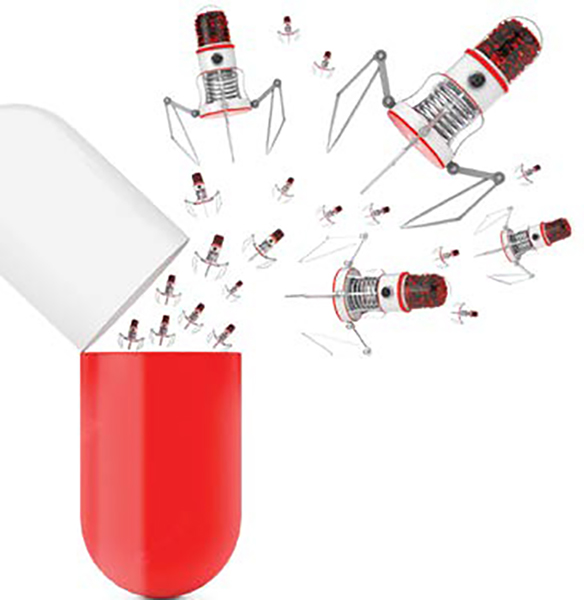As oncology drugs continue to be limited by severe side-effects and poor efficacy, resistant chronic neurodegenerative conditions remain an area of therapeutics with a huge unmet clinical need. The future of therapeutics, therefore, lies in being able to deliver therapeutic synthetic molecules intact, protected, and transported in nanoparticles to target diseased organs.

Traumatic events such as date rape, drowning or death of loved ones in accidents often necessitate the use of antidepressants for a short treatment course. Unfortunately, many antidepressant use is plagued by antidepressant discontinuation syndrome (ADS). ADS is a common problem in patients following the interruption, dose reduction, or discontinuation of antidepressant drugs. Typical symptoms of antidepressant discontinuation syndrome include extreme insomnia, nausea, gait instability, sensory disturbances, dizziness, increased suicidal thoughts and hyperarousal. These symptoms can be disabling, long-lasting, limiting the use of some antidepressants.
To reduce the incidence of ADS, PreciseMed, an R&D pharmaceutical company based in the UK is experimenting with the use of nanotechnologydriven antidepressants in discontinuation syndrome animal models. The aim is to see whether such use alleviates ADS in the animals, and hopes to transfer the technology later to humans. From the various classes of antidepressants, we selected choice examples and developed them in appropriate nanoparticles to encapsulate them on and tested these on ADS animal models to see if nanoparticles as a delivery system, which implies a lesser bioequivalent dose compared to the free form of the drugs, reduces the incidence of ADS.
Among the different classes of antidepressants, SSRIs are the most widely prescribed type of antidepressants. For this study, we used in the study are Fluoxetine, Citalopram and Paroxetine as well as other classes of choice antidepressants including serotonin-noradrenaline reuptake inhibitors (SNRIs) duloxetine, Noradrenaline and specific serotonergic antidepressants (NASSAs) mirtazapine. Others are Tricyclic antidepressants (TCAs) amitriptyline, serotonin antagonists and reuptake inhibitors (SARIs) trazodone and Monoamine oxidase inhibitors (MAOIs) phenelzine for analysis and ADS effect in an animal model.
So far, we have loaded the antidepressants into noisomes (nanoparticles) and the prepared formulations were characterised by size, polydispersity index, surface charge, and drug encapsulation.
In the ongoing ADS study we created six animal groups and five treatment groups. Each treatment group has six mice for each of the eight antidepressants- free drug forms, their nanoparticlesdriven form were delivered intraperitoneally, intranasally and rally. There was a group treated with empty nanoparticles, a group treated with citalopram as positive control and the normal saline treated group as negative control. The animals were housed in 21o C on a 12 hours light/dark cycle in open-top cages for one week prior to commencement of treatment to condition them to be depressed. Treatment was daily for 28 days and the discontinuation period where the five groups excluding the negative control group were administered with normal saline only was for three days. Anxiety was chosen as the focus discontinuation syndrome symptom for this study. The primary endpoint is to observe if there is increased Anxiety in elevated pulse maze (EPM), open field test and tail suspension test following discontinuation of treatments and to see if its occurrence is worse in the comparator arm compared to treatment arms. Should this be the case, it would call for the clinical trial of nanoparticles-driven antidepressants in depressed patients in the future to see if loading such drugs in choice nanoparticles alleviate the disabling discontinuation syndrome symptoms patients experience in real life.
For CNS drugs, COVID-19 brought to prominence its peculiar symptoms such as anosmia and ageusia (loss of smell and taste). This potentially will lead to the exploiting the olfactory bulb and trigeminal nerve route to deliver the next generation drugs for treating chronic neurodegenerative diseases, neuropsychiatry and incurable brain tumours.
CNS drugs continue to be plagued by poor absorption as less than 5 per cent bioavailability is where most CNS drugs stand at present. This is due to presence of tight junctions, the worrisome ABC drug transporters such as ABCB1 P-gp) and ABCG2 (BCRP) in the Blood-Brain Barrier (BBB) limiting CNS drugs uptake among other factors. Therefore, CNS chronic diseases therapeutics is largely an unmet clinical need space requiring novel approaches and medicines.
In line with this, our R&D company with collaborators have in the pipeline novel polymeric and nanoparticles-loaded actives as lead candidate next generation experimental therapies for Alzheimer dementia( AFXI-02), Parkinson’s disease (AFXI-03), incurable brain tumours like Gliomas, Medulloblastomas (AFXI-04, AFXI-05), depression and anxiety (AFXI- 06), developed largely as nose-to-brain formulation in “protected cargoes” to circumvent poor BBB absorption problems, ensure better tolerability and compliance for patients suffering from these chronic conditions.
Developing excellent new medicines is not going to be enough in the future for optimal patient care. The use of nanoparticles and micro-needles will dominate the therapeutic discovery scene in the next 10-20 years following the emergence of nanoparticlesdriven covid mRNA vaccines. The next-generation blockbuster drugs would have to be designed to be carried and protected in cargoes (nanoparticles) intact to choice diseased targeted organs as the new standard in the future once we get more used to developing and using the targeted approach technologies. This would not only ensure improved efficacy, minimise off-target accumulation hence reducing toxicity, but also improve the safety profile of the next-generation blockbuster medicines in addition to improving patient compliance. The mantra in the future of therapeutics is expected to be “delivering the right medicine to only the right organ in the right vehicle with the right precision”.